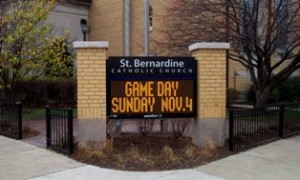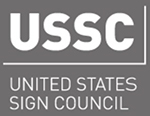From Crain's Chicago: Chicago is pushing the off button on the proliferation of brightly lit electronic advertising signs, at least temporarily.
Supported by Mayor Rahm Emanuel, a nine-month moratorium on new permits for “dynamic image display” signs smaller than 100 square feet breezed through the Zoning Committee last week and passed the City Council without debate.
The reason: Some signs have been going up around the city without aldermen first being consulted.
“That's the first I've heard of something like that,” said Rick Hotchkiss, an outdoor advertising consultant in Baltimore. “It's a continuation of the dance between the outdoor (advertising) industry and local government. It's just a different technology, but the aldermen want these type of signs minimized.”
The temporary ban doesn't affect signs larger than 100 square feet, which explicitly require City Council approval.
And it has nothing to do with 34 digital billboards that the city plans to erect along major arteries in a revenue-sharing deal with JCDecaux SA of Paris and Cherry Hill, N.J.- based Interstate Outdoor Advertising LP.
What it does affect are several small local firms that make or install a wide variety of electronic signs, as well as their customers.
“It will be a significant loss of business, not only for us but our dealers,” said Michael Mallon, regional sales manager at Danville-based Watchfire Signs Inc., which makes electronic displays. “The biggest loss is for users of our product. It's a very functional product for a lot of applications.”
While digital signs smaller than 100 square feet require city permits, they haven't required City Council approval. However, the practice of many businesses that want to put up electronic signs is to touch base with the local alderman, giving them an effective veto.
“Without editorial comment, it's the process that's in place in Chicago,” said Kenneth Peskin, manager of state and local government affairs at the International Sign Association, an industry trade group in Alexandria, Va. He flew to Chicago last week to testify against the ordinance in the Zoning Committee.
The moratorium — which started June 27, 2013, the day after it was proposed, and expires April 30, 2014 — was sponsored by Alderman Walter Burnett after several aldermen complained that they weren't being consulted about signs being installed in their wards.
“Many aldermen have received complaints that these signs are too bright, especially when they face constituents' homes,” said Alderman Danny Solis, chairman of the Committee on Zoning, Landmarks and Building Standards. “There is a proliferation of applications for new signs now that we are in the digital age.” He said the moratorium will allow the city to come up with new regulations.
However, Mr. Peskin said the ordinance is drafted in such a way that it covers almost any kind of electronic sign, no matter how small, such as a sign saying a bank's ATM is open or a sign advertising the latest jackpot for the Illinois Lottery.
“The real issue is the small number of people who put up these electronic signs who want to go around the rules or not be good neighbors” by dimming their signs at night, Mr. Stillman said. “We normally instruct customers to tone the brightness down by 80 percent at night.”
Tags
Subscribe to Parvin-Clauss's Blog






Comments